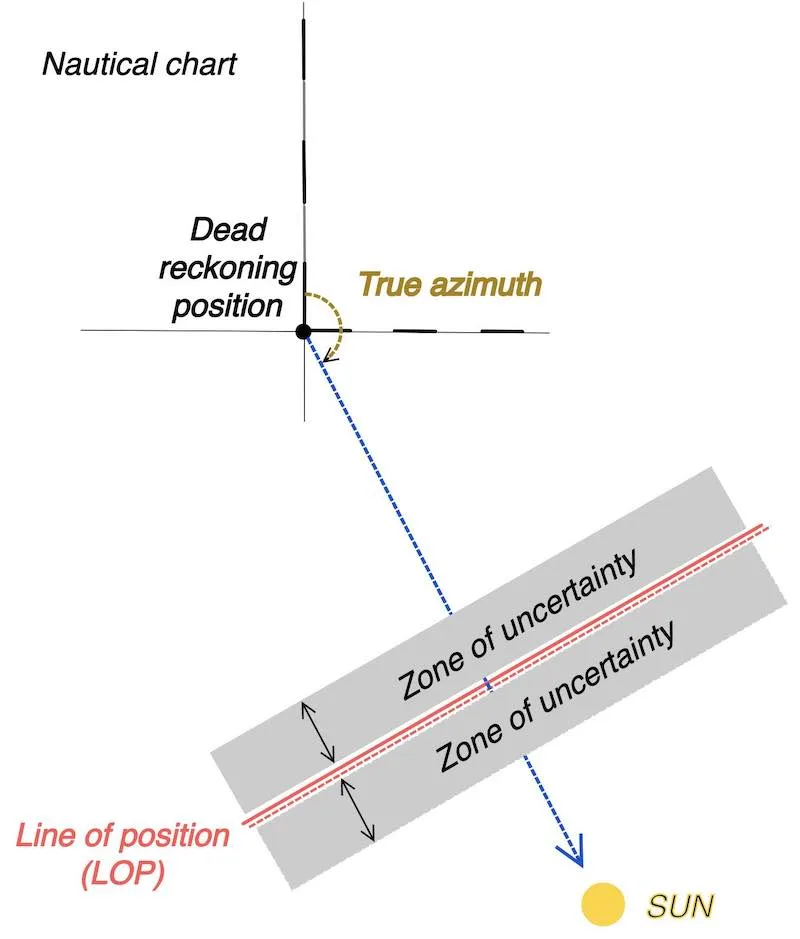Sun’s LOP Running fix and uncertainty zone: a navigational position determined by the intersection of two or more lines of position taken at different times and then advanced to a common time.

On this page dedicated to transferring a Line of Position from the sun (LOP) and the uncertainty area, as part of a self-instruction website that simulates sun observation with a sextant (refer to the first exercise), the primary goal is to guide you through all the steps using an interactive worksheet.
Ultimately, this will enable you to plot the Line of Position with its precision on a nautical chart or plotting sheet and find your way at sea.


Sun’s LOP Running fix:
1st example:
Imagine you have taken two sun sights, one at 09:00 and another at 11:30, each with different dead reckoning positions.
Distinguish these two lines of position (LOPs) on your plotting sheet (as shown below).


Now, determine your estimated true course (black) and the distance traveled (red) between the two LOP’s
Trace this true course on the plotting sheet in a way that it intersects or touches the two LOPs, with no specific restriction on its location.
Transfer the first position line forward by the estimated distance (red) and in the direction (black) the vessel is believed to have traveled between the two LOPs.
Draw the transferred position line parallel to the initial position line.
2nd example:


Here an example with a LOP in the morning and the local apparent noon LOP
3rd example



Sun’s LOP Running fix:
The uncertainty of the fix
A renowned educator in France, authoring a book on celestial navigation, suggests that considering possible minor errors in typical conditions, it is advisable to assume a margin of uncertainty of two miles on either side linked to the LOP

In addition, the transport increases the width of the uncertainty band of the transferred LOP.
The precision of the fix depends not only on the difference in azimuth.
The navigator must also take into account their confidence in the accuracy of the distance traveled and the estimated course between the two LOPs to estimate the resulting error in the fix.
The objective is to achieve a difference in azimuth of the two LOPs close to 90° while minimizing the transfer time, although this may not always be feasible.
Even when making a landfall, an uncertainty area of 6 or 8 miles is not a problem with respect to the following conditions:
Sun’s LOP Running fix and uncertainty zone:
LOP Running fix and uncertainty zone: making Landfall

Gather Essential Charts and Data: Before setting sail, ensure you have accurate charts of the intended landfall area, including coastal outlines, navigational aids, and depth contours.
Obtain precise astronomical data, such as the sun’s declination and ephemeris tables for the relevant time period.
Transition to Visual Navigation: Upon approaching your intended landfall area, switch to visual navigation using landmarks, lights, or depth soundings.
Confirm your position with multiple visual observations and adjust the course accordingly.
Ensure Safe Arrival: Once you are confident in your position, take all necessary precautions to ensure a safe arrival at the intended landfall point.
This may involve reducing speed, taking soundings, or monitoring local weather conditions.
LOP Running fix and uncertainty zone
Lighthouses

Lighthouses and celestial navigation are both important tools for maritime navigation. They are tall structures with strong lights that can be seen from great distances, used to warn mariners of dangerous areas, such as rocky coastlines or shallow waters.
Celestial navigation, on the other hand, is the practice of using the sun, moon, and stars to determine a ship’s position, offering a more precise method than using lighthouses alone.
Before your landfall, familiarize yourself with the lighthouses along the coast or near your intended landfall area. Obtain information about their characteristics (e.g., light pattern, color, and range) from navigational charts, almanacs, or other reliable sources.
When within sight of land, take bearings of lighthouses using a magnetic compass or other navigational instruments.
Compare the observed bearings with the charted bearings of the lighthouses. This will help you confirm your position and make any necessary adjustments to your estimated position.
Remember, celestial navigation requires practice and a good understanding of the sextant, timekeeping, and navigation calculations. Always be aware of the limitations of your equipment and the potential for errors in your observations.
It’s advisable to have multiple means of navigation and to cross-check your position using different methods whenever possible.
LOP Running fix and uncertainty zone:
Navigational Principle:
Following an extensive voyage, the inclination is often to reach the destination swiftly.
However, it’s essential to prioritize making prudent decisions, even if it means diverging from the preferences of your crew or passengers.
Opting to spend the night at sea might be necessary for a clearer visual and to ensure a safe arrival at the intended port.